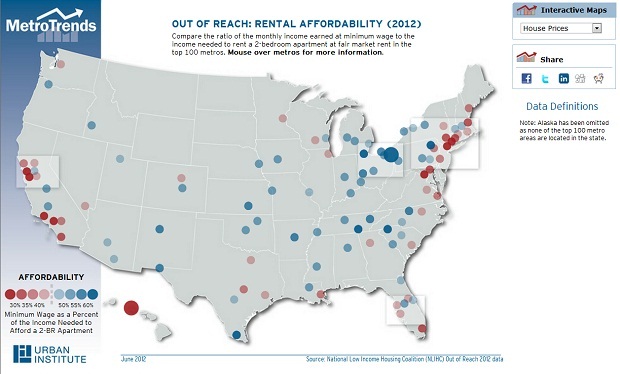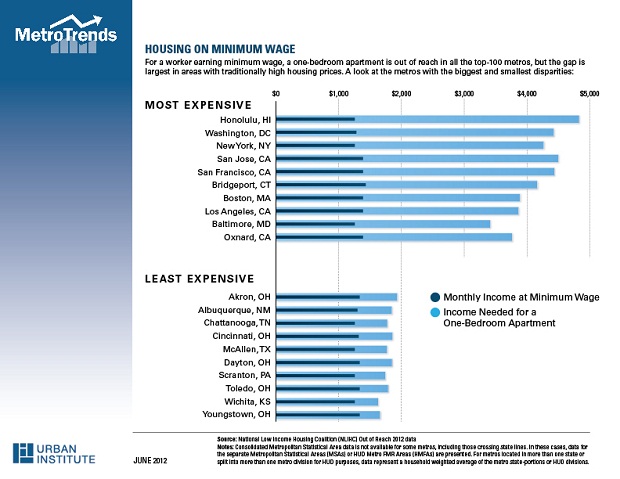
|
|
Stark Realities of Renting in America Out of Reach Shows Stark Realities of Renting in Metropolitan AmericaMegan Bolton Topic: Housing Data Source: Out of Reach The National Low Income Housing Coalition's (NLIHC) annual Out of Reach report helps advocates all over the country educate their local, state and federal representatives about the need for affordable housing by showing standard wages and rents in every county, metropolitan area, combined nonmetropolitan area and state in the U.S. While housing costs vary greatly from place to place, one thing holds true all over: it is very difficult for renters earning low or average wages to live in their communities affordably. The most cited statistic in Out of Reach is the Housing Wage. This is the hourly wage needed to afford the 2 bedroom Fair Market Rent (FMR) while working 40 hours per week, 52 weeks a year. The FMR is HUD's best estimate of the cost of rent and utilities for a modest rental house or apartment on the private market. In most areas it is the 40th percentile rent in the local rent distribution, adjusted for both substandard and luxury units. We rely on the FMR because it is the best estimate of the rents that a household moving today would find on the market for a safe, standard unit with basic amenities. Out of Reach shows how difficult it would be for people like new college graduates or low paid workers with children to find a place to live. The supply of low cost rental units is diminishing and the increased demand for rental units has caused rents in many previously affordable developments to go up. In 2012, the national Housing Wage is $18.25, and for the top 100 metropolitan areas, it is $20.14. There are four metro areas with a Housing Wage over $30: San Francisco, CA, Stamford-Norwalk, CT, Honolulu, HI and San Jose-Sunnyvale-Santa Clara, CA. And in fact, the metro areas in the West and the Northeast tend to have higher housing wages than those in the South and Midwest. In the West, the most expensive region, rents hover around $996 for a one bedroom apartment and $1,218 for a 2 bedroom apartment. Yet, a minimum wage worker in California, earning just $8 per hour, can only afford rent of $416 per month, and an extremely low income (ELI) household in the western metro areas, earning just 30% or less of the area median income (AMI), can only afford to spend $555 per month on rent. Even those earning the average renter wage of $16.76 are earning almost $7 per hour below the Housing Wage for that region. While it's clear that things are tough in the west, in none of the top 100 metropolitan areas would a minimum wage worker be able to afford a 1-bedroom apartment working just 40 hours per week, 52 weeks a year. Even renters in more affordable metro areas in the Midwest and South face problems with housing affordability because of incomes that are often lower than those in the West and Northeast. For example, in the Midwest, FMRs are $685 for a one bedroom apartment and $816 for a two bedroom apartment, but an individual renter earning the federal minimum wage of $7.25 per hour can afford rent of just $377 per month. The average ELI household in the Midwest doesn?t fare much better. With an annual income of just over $21,000, this household can only afford a monthly rent of $534. Keep in mind that one out of every four households in the U.S. was considered ELI in 2010. The Housing Wage in the Midwestern metro areas is $15.69, which remains above the average renter wage of $13.18 for that region. In NLIHC's last posting on MetroTrends using the Urban Institute's "Double Trouble" typology and data from the 2011 Out of Reach report, we saw that the metropolitan areas with the highest housing wages tend to be those where home prices have fallen since the recession, and this has likely led to an increase in the demand for rental housing. As the demand for rental housing increases, rents also increase. In order to afford these high rents, workers are forced to either find more than one job or spend a large portion of their income on the cost of rent and utilities, leaving them very little income to take care of student loan payments, child care, transportation and other necessities. In Out of Reach 2012 the map showing the number of hours needed to work in order to afford the 2-bedroom FMR in each state is getting a lot of attention. We think it resonated with a lot of Americans who continue to struggle to find an affordable place to live and a well paying job. It is clear that we must focus on preserving the existing stock of affordable rental housing and we must ensure that as more rental housing is built, there be units that are affordable to the lowest income Americans. |
Experts Feedback
Send us your comments to help further the discussion. Share
Commentaries
|






